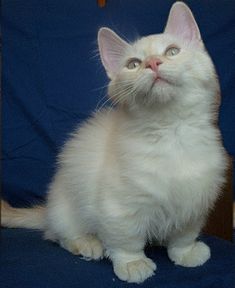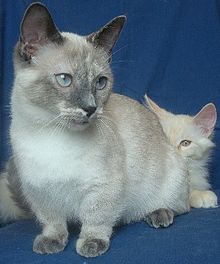- Munchkin (cat)
-
Munchkin 
Adolescent munchkin kitten. Origin United States Breed standard TICA standard Notes Color: Seal color point long haired. Cat (Felis catus) The Munchkin is a cat breed created by a naturally occurring genetic mutation that results in cats with abnormally short legs. However, the shortness of their legs does not seem to interfere with their running and leaping abilities.[1] The gene responsible has been compared to the one that give Welsh Corgis, Basset Hounds and Dachshunds their short stature; however, Munchkins do not suffer from the many spinal problems that are typically associated with those canine breeds[2] as cats' spines are physically different from dogs'. The spine of a Munchkin cat is usually indistinguishable from that of other cats.[3]
Contents
History
Throughout history and around the globe there have been sightings of short-legged cats from Russia to Germany to Great Britain.[4] A breeding population existed in Europe around the middle of twentieth century but the lines died out during and after the Second World War.[5]
The breed was first documented in the United States in 1964 by Ellen Kasten in the town of Westbury, New York. However, the cat was not bred and therefore was not rediscovered until 1983 when a music teacher in Louisiana found two pregnant cats.[6] Half of the kittens of one litter were short-legged, and It is from this line that today's Munchkin breed is descended.
The Munchkin was first introduced to the general public in 1991 via a national network televised cat show held by The International Cat Association (TICA) in Madison Square Garden.[7] Critics predicted that the breed would develop back, hip and leg problems similar to those that plague some Dachshunds.[8] Studies were conducted by Dr Solveig Pflueger (Chief of the genetics committee for TICA) who determined that the Munchkins were physically sound.[6] Amidst much controversy, TICA accepted the Munchkin into its New Breed development program in September 1994. One veteran show judge—who had Munchkin supporters threatening to burn her house[9]—resigned in protest, calling the breed an affront to breeders with ethics.[10] The Munchkin achieved TICA Championship status in May 2003.[4]
Behavioral Characteristics
The Munchkin is generally described as a sweet-natured, playful, people-oriented, outgoing and intelligent cat which responds well to being handled.[3][11] As pets they are very playful and outgoing; they don't let their shorter legs hinder them from doing things that other cats do.
Physical Characteristics
The Munchkin is a small to medium sized cat with a moderate "semi-foreign" body type. A male Munchkin typically weighs between 3–4 kg (6-9 lbs) and is usually larger than a female Munchkin, which typically weighs between 1,8-3,6 kg (4-8 lbs).[7] The short legs of the Munchkin may be slightly bowed, although excessive bowing is a disqualification in the show ring. Cow-hocked legs are also penalized. The hind legs can be slightly longer than the front. According to the Animal Planet show Cats 101, there are three types of legs on Munchkins: standard, super-short, and rug hugger.
The body of the Munchkin cat is medium sized with a level spine with a slight rise from the shoulder to the rump.[12]
For TICA shows, they are separated by fur length into two groups: Munchkin and Munchkin Longhair. The short-haired variety has a medium-plush coat while the Long-haired has a semi-long silky coat. The Munchkin comes in all colors and patterns.[4] This variety stems from the outcross program, which allows the use of any domestic cat that does not already belong to a recognized breed. Similarity to other breeds is grounds for disqualification.[11]
Health
For the most part Munchkins are a healthy and hearty cat that in general suffer from the same common health problems as other cats but lordosis and pectus excavatum have been documented conditions seen in a few Munchkin cats. These are rare medical conditions seen in other cat breeds too and are not specific to the Munchkin breed.
Dr. Solveig Pflueger, chairperson of TICA's genetics committee and advisor to the Board of Directors conducted studies on the Munchkin cats to determine the over all genetic health of the breed. Based on the research she discovered them to be "happy healthy cats" and that they should have a future as a Championship breed.[13] In 1995 several Breeders had their oldest Munchkins X-rayed and examined for signs of joint or bone problems and no problems were found.[13]
Advocates and critics
The Munchkin cat is the result of a genetic mutation and some people believe that they should not be continued to be bred but others see little difference in a short legged cat breed and the short legged dog breeds such as the Dachshund, Bassett hound and Corgi.[14]
There is controversy among breeders of pedigree cats as to what genetic mutations are abnormal and potentially disadvantageous to the cat.[15] The Australian Capital Territory (a territory of Australia) government consider the munchkin breed to be "malformed animals" and the deliberate breeding of them "unacceptable" because of the "genetic health problems associated with such breeding".[16] Owners and Breeders of munchkins declare them to be "a sound breed" that is "ideal" for small homes and not particularly susceptible to health problems.[17]
Small litter sizes when two munchkin cats are crossed indicate that embryos which are homozygous for the munchkin gene are non-viable.[18]
Several cat registries do not recognize the Munchkin: Fédération Internationale Féline, which refuses to recognise what they consider a breed based on a "genetic disease", achondroplasia.[19] The Governing Council of the Cat Fancy likewise refuses to recognise the breed, considering this breed and others like it to be "unacceptable" because they are based on an "abnormal structure or development".[20] The breed is also not recognized by the Cat Fanciers' Association.[21]
Apart from TICA, registries that recognize the breed includes The American Association of Cat Enthusiasts, UK's United Feline Organization, the Southern Africa Cat Council,[22] the Waratah National Cat Alliance in Australia,[17] and Catz Incorporated in New Zealand.
Biology
Although the genetic mutation causing the short-legged trait in munchkin cats is often referred to as achondroplasia,[19] it has not yet been proven that the trait is due to a gene at the same locus as causing achondroplasia in humans. Furthermore, while achondroplasia is typically associated with an enlarged head as well as short legs, a combination of features not seen in munchkin cats, the condition has sometimes been referred to as hypochondroplasia instead.[18]
Genetics
The munchkin gene is an autosomal dominant one.[19] Homozygous embryos for the munchkin gene are not viable due to gene lethality. Only kittens that are heterozygous for the munchkin gene develop into viable short legged munchkin kittens.[18] Because only heterozygous munchkin cats are able to pass on the gene, all litters with at least one munchkin parent have the possibility of containing kittens with the phenotypes: short-legged or normal-legged (referred to as non-standard munchkin), with the genotypes of Mm or mm, where M is the trait for short legs and m is the trait for long legs. A litter with two munchkin parents, Mm x Mm, have the chance of producing these offspring: 25% MM- a nonviable kitten, 50% Mm-short-legged, 25% mm- normal.
Punnett squares, in which the M represents the dominant munchkin gene and the m represents the recessive normal gene, may be used to illustrate the chances of a particular mating resulting in a short-legged cat.
Kittens bearing two copies of the munchkin gene (MM) will not survive. Kittens bearing one munchkin gene and one normal gene (Mm) will be short-legged munchkins. Kittens bearing two normal genes (mm) will be normal. Mm munchkin kittens will be able to pass on the munchkin gene to their own offspring. Normal mm kittens will not, as they do not have a copy of the munchkin gene.
Mating two standard munchkins: M m M MM Mm m Mm mm For each kitten born from this mating, there is a 25% chance it will not survive, a 25% chance it will be normal, and a 50% chance it will be short-legged. For each kitten born from this mating, there is a 0% chance it will be non-viable (unless it has a different, unrelated condition), a 50% chance it will be normal, and a 50% chance it will be a munchkin. Mating a standard or non-standard munchkin with a normal cat: M m m Mm mm m Mm mm Recognized crossbreeds
The Munchkin has been crossed with the curly coated LaPerm to create the Skookum, the hairless Sphynx to create the Minskin, with the uber curly coated Selkirk Rex to produce the Lambkin, the Persian to create the Napolean and crossed with the Bengal to create the Genetta.
See also
- Cat body type genetic mutations
- Scottish Fold, a variety of cat with a gene causing osteochondrodysplasia rather than achondroplasia.
References
- ^ Stroud, Jon (2008). The DVD Book of Cats.. Green Umbrella publishing.
- ^ [1], CatWorld.
- ^ a b [2], Cats United.
- ^ a b c Munchkin Breed Introduction. The International Cat Association.
- ^ [3], Cat Breed info, The Munchkin Cat Breed.
- ^ a b Stall, Sam (2007). 100 Cats Who Changed Civilization: History's Most Influential Felines. Quirk Productions, Inc.
- ^ a b Helgren, J. Anne (2006). "Iams Cat Breed Guide: Munchkin". Telemark Productions. http://www.iams.com/iams/en_US/jsp/IAMS_Page.jsp?pageID=CBD&breedPage=munchkin.html. Retrieved 7 February 2010.[dead link]
- ^ "A Cat Fight Breaks Out Over a Breed". Associated Press. July 23, 1995. http://www.nytimes.com/1995/07/23/us/a-cat-fight-breaks-out-over-a-breed.html?pagewanted=1. Retrieved 7 February 2010.
- ^ Owen, Susan Marquez (July 21, 1995). "Critics Dog Cat". Los Angeles Times. http://articles.latimes.com/1995-07-21/local/me-26310_1_international-cat?pg=2. Retrieved 7 February 2010.
- ^ Helgren, J. Anne (1998). "Encyclopedia of Cat Breeds: Munchkin Cat". Barron's Educational Series. http://www.petfinder.com/cat-breeds/Munchkin. Retrieved 7 February 2010.
- ^ a b "Munchkin Breed Group Standard". The International Cat Association. 05/01/2007. http://www.tica.org/public/breeds/mk/mk.pdf. Retrieved 9 February 2010.
- ^ Fogle, Bruce (2003). Cat Owner's Manual. Dorling Kindersley.
- ^ a b [4], PetStyle Lifestyle Network For Pet Lovers.
- ^ Spadafori, Gina (2000). Cats For Dummies, 2nd edition. Hungry Minds, Inc.
- ^ Morris, Desmond S. (1988). Catwatching & Catlore. Arrow Books Ltd.. pp. 183–186. ISBN 0-09922-901-3.
- ^ Australian Capital Territory, Code of Practice for the Welfare of Cats in the ACT
- ^ a b Waratah National Cat Alliance, Munchkin Breed Profile
- ^ a b c Genetic Abnormalities of Cats. Messybeast.com Cat Resource
- ^ a b c Breeding and Registration Rules: 2.7.3 Genetic Diseases. Fédération Internationale Feline
- ^ The Governing Council of the Cat Fancy, The GCCF says Health Comes First
- ^ Cat Fanciers' Association,CFA Breeds
- ^ Southern Africa Cat Council, The Southern Africa Cat Council, Breed Standards (Foreign Breeds)
External links
- Is tiny Heed the world's smallest cat? The Guinness Book of Records is waiting until this little Munchkin kitten is fully grown to decide if he is a record breaker.
Categories:- Cat breeds
- Cat breeds originating in the United States
Wikimedia Foundation. 2010.

